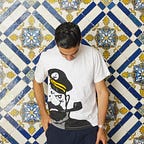Redesigning Persepolis
Persepolis is one of Iran’s two football giants. Founded in 1967, it has been attracting the country’s top football talent for generations and its games regularly bring out sellout crowds of 100,000+ to Tehran’s Azadi stadium.
A little bit of history
Persepolis was named after the ancient ceremonial capital of the Persian empire, reflecting the state-sponsored nationalist discourse of its time which glorified Iran’s historic past. The imposing, intricately carved stone reliefs found on the ruins of Persepolis provided artistic inspiration for many brands in the 60’s, including Persepolis.
After the 1978 Islamic revolution, symbols of Iran’s pre-Islamic past were no longer promoted, and so the state — who had taken over the club — tried to change its name to Pirouzi (or “victory” in Persian). But some things are hard to change, and despite publication bans and years of state media orders, people by and large refused to let go of the old name. In 2012 the club officially reverted its name back to Persepolis.
Logo
Throughout the years, Persepolis’s logos have always been inspired by the Achaemenid art found in its namesake’s ruins. The club’s first logo featured a Faravahar; a winged Zoroastrian deity (today it is considered a kitsch nationalist symbol). It sat in the middle of a creatively crafted frame of lotus flowers (again, inspired by the carved ruins), terminating in a humorously pointy scroll that housed the club’s name. While not terribly creative, the logo exuded a certain charm.
Later logos removed the Faravahar, opting to use other architectural elements found in Persepolis like carved creatures atop its column capitals. A trophy was also added. The newer designs were better at capturing the power of Persepolis as a place, with its soaring columns and menacing statues. However, they had no soul. They took the architectural subject too literally with crudely crafted lines of varying stroke thickness. They also misspelled the club’s name — and still do to this day. But the biggest sin was the introduction of the police-badge-like shield. While there’s nothing wrong with looking for inspiration globally, this crest style is a completely foreign transplant and has no connection to either Iran’s visual art traditions or war shields from various historic eras. With this mind, I decided to create a new logo for Persepolis.
The new logo
I had several goals as I set about doing this redesign:
- Maintaining brand continuity by keeping the griffins and trophy elements
- Bringing back some of the old logo’s lost charms
- Remaining faithful to Iranian visual art traditions
The design achieves these goals by combining elements from the new and old logos.
Specifically, three things combine to create the new form:
- Anchoring the shape is an elementary version of the faravahar containing its wings, tail, and the central circle (which doubles as a sports ball)
- Two griffins, inspired by the Homa and Lions found in Persepolis adorn either side; their light and dark colors also represent the dualism in Zoroastrianism whose motifs frequently appear at Persepolis
- A trophy still occupies the center, with an etched torso that is also a nod to Persepolis’s carved columns
For the wordmark, I’m using United; a robust type that helps achieve the modern-retro look I was going for, and a custom Persian type that mirrors the same chiselled forms.
What now?
I hope this work inspires Persepolis and other brands in Iran to pay more attention to design as means of connecting with people. For myself, this is the first project in a series I’m calling “Redesigning Iran”. I’m planning on doing the same exercise for other iconic Iranian brands in the hopes of stimulating more conversations around design. If you want to stay up to date with future case studies in this series you can follow me on Twitter or follow Redesigning Iran on Medium.
About the author
Pendar is a former amateur blogger, ex- dabbler in web comics, serial clothing line creator, and featherweight influencing champion who gave up the glamours of the expat blogging social scene for a career in interaction design. He now lives with his wife and two cats in sunny California. Outside of corporate slavery he watches Netflix and runs IranianApparel.com.
